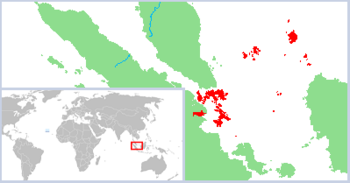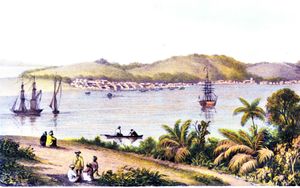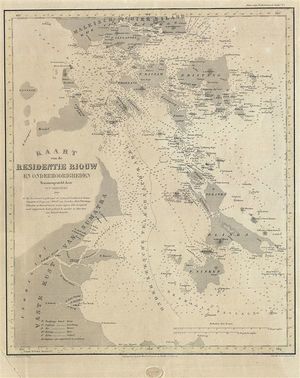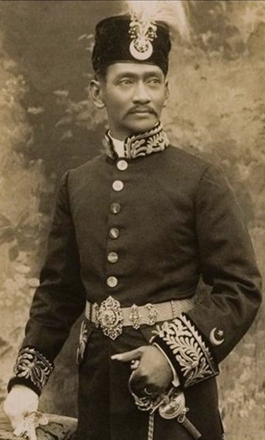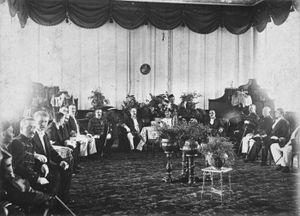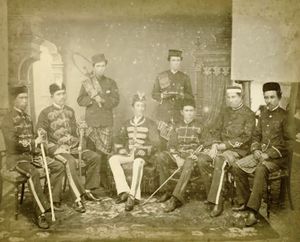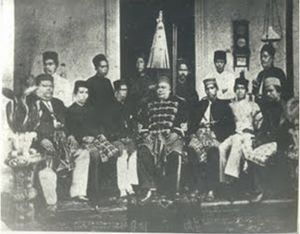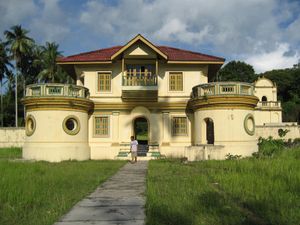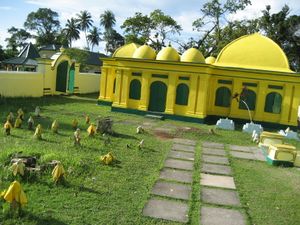سلطنة رياو-ليڠگا
| ||||||||||||||||||||||||||||||||||||||||||||||||||||||||||||||||||
| ||||||||||||||||||||||||||||||||||||||||||||||||||||||||||||||||||
سلطنة رياو-ليڠگا (Malay/Indonesian: Kesultanan Riau-Lingga, Jawi: کسلطانن رياوليڠݢ), also known as the Lingga-Riau Sultanate, Riau Sultanate or Lingga Sultanate was a Malay sultanate that existed from 1824 to 1911, before being dissolved following Dutch intervention.
The sultanate came into existence as a result of the partition of the Johor-Riau Sultanate that separated Peninsular Johor, together with the island of Singapore, from the Riau archipelago. This partition followed the succession dispute following the death of Mahmud III of Johor, when Abdul Rahman was crowned as the first Sultan of Riau-Lingga. The maritime kingdom was recognised by both the British and the Dutch following the المعاهدة الإنگليزية الهولندية 1824.
التاريخ
خلفية
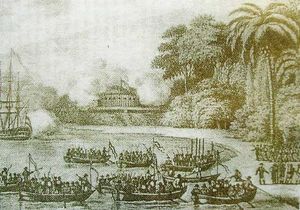
The Riau Archipelago became a part of the Malaccan Empire after the expansion by Tun Perak in the 15th century, following the decline of the Srivijaya Empire. After the fall of Malacca at the hands of the Portuguese, the axis of regional power was inherited by the Johor Sultanate. During the golden age of Johor, the kingdom stretched across half of the Malay Peninsular, eastern Sumatra, Singapore, Bangka, Jambi and the Riau Islands.
According to the 1849 Johor Annals, on 27 September 1673 the Laksamana (admiral) of Johor, Tun Abdul Jamil, was ordered by Abdul Jalil Shah III to found a settlement in Sungai Carang, Ulu Riau, on Bintan Island. The settlement in Sungai Carang was later known as Riau Lama. Initially a fortress to protect the Johor Empire, Riau Lama then prospered and became an increasingly prominent entrepôt for regional trade in the Strait of Malacca.
السلطان بدر العالم شاه الثاني
تصاعد القومية
الفض على يد الهولنديين

The bold resolution shown by the sultan and fellow officials was not welcomed by the Dutch. According to the journal kept by the Syahbandar (Harbourmaster), the decision of the sultan was deplored by the Dutch Resident, G.F Bruijn Kops who stated "they molded the sultan to retaliate (against the Dutch), so a retaliation (by the Dutch) shall be administered".
الأعقاب
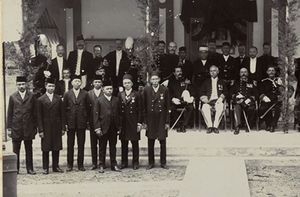
الحكومة
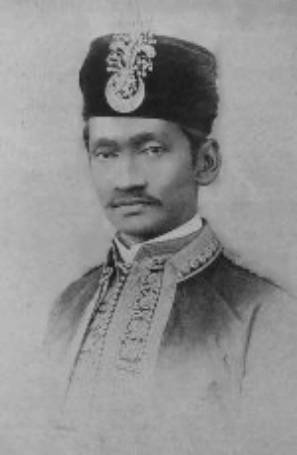
Adat
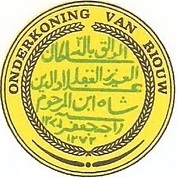
The pledge of allegiance included the following words:
| Jawi script | Rumi script | English translation |
|---|---|---|
...جكالاو توان كڤد بوڬيس |
...jikalau tuan kepada Bugis, |
"... if he was an ally to the Bugis |
Yang Dipertuan Muda
قائمة المسئولين
سلاطين رياو
| سلاطين جوهر-رياو | العهد |
|---|---|
| Malacca-Johor Dynasty | |
| Alauddin Riayat Shah II | 1528–1564 |
| Muzaffar Shah II | 1564–1570 |
| Abdul Jalil Shah I | 1570–1571 |
| Ali Jalla Abdul Jalil Shah II | 1571–1597 |
| Alauddin Riayat Shah III | 1597–1615 |
| Abdullah Ma'ayat Shah | 1615–1623 |
| Abdul Jalil Shah III | 1623–1677 |
| Ibrahim Shah | 1677–1685 |
| Mahmud Shah II | 1685–1699 |
| Bendahara Dynasty | |
| Abdul Jalil Shah IV | 1699–1720 |
| Malacca-Johor Dynasty (descent) | |
| Abdul Jalil Rahmat Shah (Raja Kecil) | 1718–1722 |
| Bendahara Dynasty | |
| Sulaiman Badrul Alam Shah | 1722–1760 |
| Abdul Jalil Muazzam Shah | 1760–1761 |
| Ahmad Riayat Shah | 1761–1761 |
| Sultan Mahmud Shah III | 1761–1812 |
| Abdul Rahman Muazzam Shah | 1812–1832 |
| Muhammad II Muazzam Shah | 1832–1842 |
| Mahmud IV Muzaffar Shah | 1842–1857 |
| Sulaiman Badrul Alam Shah II | 1857–1883 |
| Yang Dipertuan Muda Dynasty | |
| Abdul Rahman II Muazzam Shah | 1883–1911 |
Yang di-Pertuan Muda of Riau
| Yang di-Pertuan Muda of Riau | In office |
|---|---|
| Daeng Marewah | 1722–1728 |
| Daeng Chelak | 1728–1745 |
| Daeng Kemboja | 1745–1777 |
| Raja Haji | 1777–1784 |
| Raja Ali | 1784–1805 |
| Raja Ja'afar | 1805–1831 |
| Raja Abdul Rahman | 1831–1844 |
| Raja Ali bin Raja Jaafar | 1844–1857 |
| Raja Haji Abdullah | 1857–1858 |
| Raja Muhammad Yusuf | 1858–1899 |
National symbol
Flags of the Riau-Lingga Sultanate
The earlier flag of Riau Sultanate was established on 26 November 1818.[مطلوب توضيح] It was provided in section 11 of the Royal decree that the flag of the Sultanate of Riau should be black with a white canton. The similar flag design was also adopted by its sister state of Johor.
Royal and noble ranks
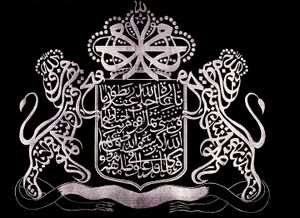
Royal family
- Sultan: The reigning prince was styled the Sultan (personal reign name) ibni al-Marhum (father's title and personal name), Sultan of Riau, Lingga and dependencies, with the style of His Highness.
- Tengku Ampuan: The senior consort of the ruling prince.
- Tengku Besar: The Heir Apparent.
- Tengku Besar Perempuan: The consort of the Heir Apparent.
- Tengku Muda: The Heir Presumptive
- Tengku Muda Perempuan: The consort of the Heir Presumptive.
- Tengku: The other sons, daughters and descendants of Sultans, in the male line: They would be styled as Tengku (personal name) ibni al-Marhum (father's title and personal name).
Yang Dipertuan Muda
- Yang di-Pertuan Muda: The ruling prince of Riau, with the style of His Highness. In earlier days, the ruling prince also received the personal title of Sultan and a reign name.
- Raja Muda: The Heir Apparent, styled as Raja (personal name) bin Raja (father's name), Raja Muda.
- Raja: The sons, daughters, grandchildren's and other descendants of the ruling prince, in the male line: Raja (personal name) bin Raja (father's name).
Territory
Following the partition of Johor and the relinquishing of rights over the mainland peninsular, the sultanate was effectively a maritime state. The Riau Sultanate's dominions encompassed the Riau, Lingga and Tudjuh Archipelago, including Batam, Rempang, Galang, Bintan, Combol, Kundur, Karimun, Bunguran, Lingga, Singkep, Badas, Tambelan, Natuna, Anambas and many smaller islands. There were also several territories in Igal, Gaung, Reteh and Mandah located in Indragiri on mainland Sumatra. All these territories were headed by a Datuk Kaya (nobleman), known as an Amir (equivalent to a Viscount) who had been chosen by the sultan or by the ruling elite to deal with the local administration.
Foreign relations and trade
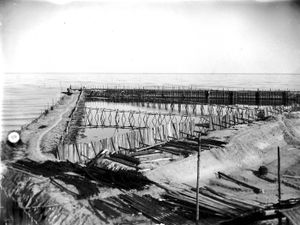
Legacy
The sultanate is widely credited in the development of the Malay and Indonesian language, as various books, literary works and dictionary was contributed in the sultanate. These works formed as the backbone of the modern Indonesian language. Raja Ali Haji, was celebrated for his contribution on the language and honoured as the National Hero of Indonesia in 2004.[2]
انظر أيضاً
- Malay people
- Malayness
- Johor Sultanate
- Selangor Sultanate
- Malacca Sultanate
- Siak Sri Indrapura Sultanate
- Singapura Kingdom
- Srivijaya Kingdom
- Riau Archipelago
- Johor
- List of Sunni Muslim dynasties
Notes
- ^ خطأ استشهاد: وسم
<ref>غير صحيح؛ لا نص تم توفيره للمراجع المسماةhubert-herald1 - ^ "Raja Ali Haji" (in Indonesian). Yogyakarta: Balai Melayu. Archived from the original on 2 April 2015. Retrieved 12 March 2015.
{{cite web}}: CS1 maint: unrecognized language (link)
Bibliography
- Barbara Watson Andaya (2003) Gender, Islam and the Bugis Diaspora in Nineteenth and Twentieth-Century Riau, Kuala Lumpur:National University of Malaysia, online edition
- Vivienne Wee (2002) Ethno-nationalism in process: ethnicity, atavism and indigenism in Riau, Indonesia, The Pacific Review, online edition
- Mun Cheong Yong (2004) The Indonesian Revolution and the Singapore Connection, 1945-1949, Singapore: KITLV Press, ISBN 9067182060
- Derek Heng, Syed Muhd Khirudin Aljunied (ed.) (2009) Reframing Singapore: Memory, Identity, Trans-regionalism, Singapore: Brill Academic Publishers, ISBN 9789089640949
- Virginia, Matheson (1989) Pulau Penyengat : Nineteenth Century Islamic Centre of Riau, online edition
- Barbara Watson Andaya (1977) From Rūm to Tokyo: The Search for Anticolonial Allies by the Rulers of Riau, 1899-1914, online edition
- جميع الصفحات التي تحتاج تنظيف
- مقالات بالمعرفة تحتاج توضيح from February 2017
- Indonesia articles missing geocoordinate data
- All articles needing coordinates
- History of Johor
- History of Sumatra
- دول إسلامية في إندونيسيا
- Former sultanates
- Former countries in Southeast Asia
- Former monarchies
- دول قبل الاستعمار في إندونيسيا
- Former countries in Indonesian history
- Former countries in Malaysian history
- بلدان جزر
- History of Singapore
- History of Malaysia
- History of Indonesia


